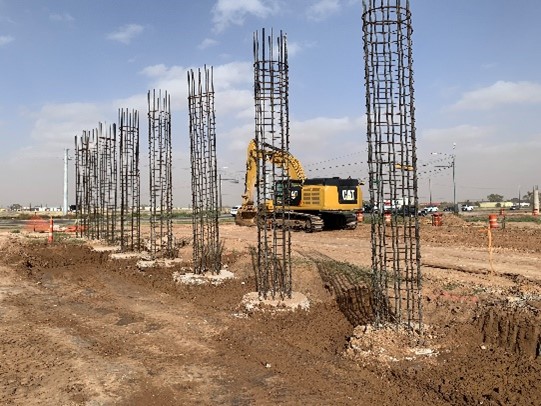Consulting Civil Engineering Companies Giving Geotechnical Solutions
Wiki Article
A Thorough Exam of the Services Given by Consulting Engineers in the Field of Geotechnical Engineering: From Website Examination to Project Implementation
Consulting engineers in geotechnical design play a pivotal duty in the successful implementation of building projects, beginning with comprehensive site investigations that reveal important subsurface problems. Their knowledge extends to dirt residential or commercial property assessments, ecological influence evaluations, and the mindful tracking of project implementation, guaranteeing positioning with security and sustainability standards.Importance of Geotechnical Design
Geotechnical engineering is an important technique that underpins the safety and sustainability of civil infrastructure jobs. By recognizing the mechanical habits of dirt and rock materials, geotechnical engineers analyze the viability of websites for different constructions, consisting of buildings, bridges, and dams. This essential analysis makes certain that structures can stand up to ecological elements and tons without experiencing failing.The value of geotechnical engineering expands past plain structural security; it likewise includes ecological stewardship. Appropriate geotechnical assessments add to lessening the environmental effect of building. Through cautious analysis of soil residential or commercial properties and groundwater conditions, engineers can design structures and retaining structures that reduce threats such as erosion and landslides, advertising long-term security.
Moreover, geotechnical engineering plays a crucial role in job expense monitoring. geotechnical works. By determining possible issues early in the layout stage, designers can suggest appropriate remedies, hence preventing expensive delays and redesigns during building and construction. This positive strategy not just boosts project efficiency yet additionally significantly reduces dangers linked with unexpected site problems
Website Investigation Strategies
Effective website examination strategies are necessary for gathering precise data concerning subsurface problems before building and construction. These techniques help with the understanding of the geological and hydrological setting, which is vital for making certain the security and security of suggested frameworks.Typical techniques utilized in site examinations consist of borehole boring, which permits designers to remove dirt examples at different midsts, offering insights right into stratification and product types. On top of that, geophysical studies, such as seismic refraction and electrical resistivity, deal non-invasive means to assess subsurface qualities over larger areas. These techniques can help recognize anomalies without comprehensive excavation.
Examination pits are another important technique, providing straight observation of soil layers and allowing in-situ screening. geotechnical works. This technique is specifically helpful for superficial excavations and can assist examine groundwater levels. Moreover, cone penetration examinations (CPT) are progressively used, as they provide continuous profiles of soil resistance, which assists in establishing dirt toughness and layering.
Each of these techniques plays a crucial role in establishing an extensive understanding of site conditions, making it possible for consulting engineers to make educated choices and referrals throughout the job lifecycle. Precise data collection throughout the website investigation stage is pivotal to mitigating threats and ensuring effective job execution.
Soil Residential Or Commercial Property Analysis

The assessment procedure typically involves a combination of lab examinations and area investigations. Key residential properties such as shear stamina, compressibility, permeability, and dampness content are evaluated to establish the soil's viability for building and construction objectives. Common tests, consisting of the Atterberg limitations, Proctor compaction, and triaxial shear tests, are generally employed to collect data on dirt habits.
In addition to these tests, in-situ techniques such as the Criterion Infiltration Examination (SPT) and Cone Infiltration Test (CPT) use valuable understandings right into dirt stratigraphy and density. The results of these analyses educate designers regarding possible challenges, such as dirt liquefaction or settlement, enabling them to design proper mitigation methods.
Environmental Effect Examination
Environmental impact examination plays a critical function in the preparation and implementation of engineering projects, specifically in geotechnical engineering. This procedure includes assessing the potential ecological effects of proposed projects on dirt, water, air quality, and surrounding communities. Consulting designers use various approaches, including website analyses, modeling, and area studies, to identify and measure these effects.The analysis commonly begins with the recognition of baseline ecological conditions, which functions as a referral for forecasting possible adjustments. Engineers analyze variables such as disintegration, groundwater contamination, and environment interruption, guaranteeing that all appropriate environmental guidelines and guidelines are followed throughout the job lifecycle. Stakeholder engagement is also an important part of the analysis anonymous process, as it promotes interaction between job designers, local communities, and regulatory bodies.
Additionally, mitigation techniques are created to deal with recognized influences, permitting designers to recommend choices or modifications to predict designs that enhance sustainability. This positive approach not just minimizes damaging results on the atmosphere yet likewise advertises public trust fund and compliance with environmental legislation. Ultimately, efficient Read Full Article environmental influence analysis enhances the general integrity and practicality of geotechnical engineering tasks, supporting liable advancement methods.
Task Application and Tracking

Tracking is a vital element of project execution. Designers utilize various methods, such as instrumentation and area examinations, to assess soil habits and architectural actions in real-time. This continuous monitoring enables the recognition of any inconsistencies from anticipated efficiency, enabling for timely interventions to mitigate threats.
Moreover, seeking advice from designers maintain open communication with service providers and stakeholders throughout the process. Routine website inspections and report card ensure that all celebrations are informed regarding task condition and any arising concerns. By fostering partnership and transparency, consulting designers assist in a much more effective execution process, thus improving project outcomes.
Ultimately, reliable job application and monitoring not only support safety and high quality criteria however additionally contribute to the overall success of geotechnical jobs, guaranteeing they meet their intended objectives sustainably and responsibly.

Final Thought
In conclusion, the function of consulting engineers in geotechnical engineering encompasses a vital series of solutions that guarantee project success. Inevitably, the diverse contributions of consulting designers are vital in dealing with the complexities of geotechnical wikipedia reference obstacles in modern-day engineering tasks.Report this wiki page